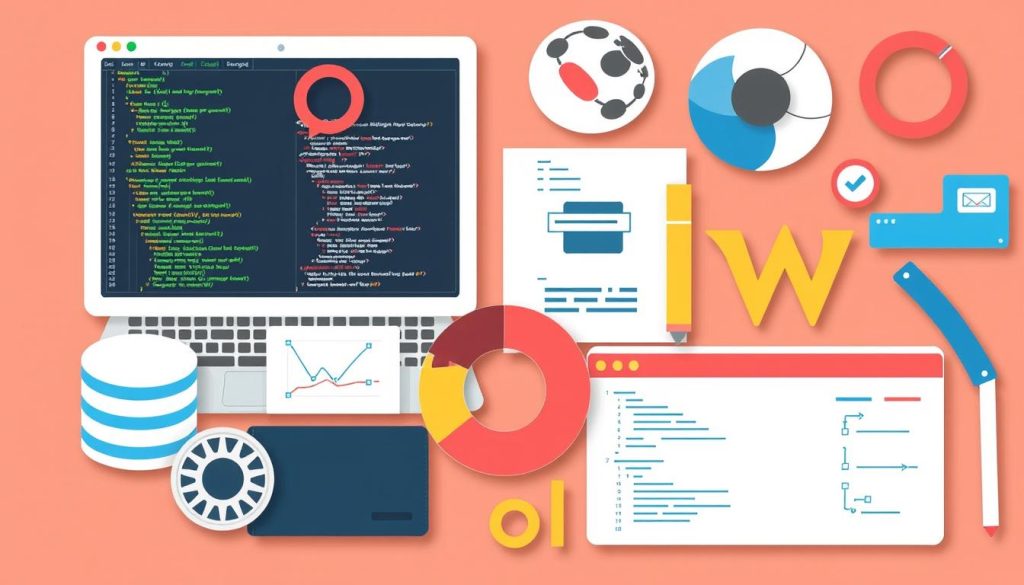Web development is key in today’s digital world. Over 80% of websites use HTML, and 95% use CSS. These technologies are vital for making professional websites. Understanding web development, including front-end and design, is essential.
In the U.S., web developers earn between $50,000 and $100,000. The job market is expected to grow by 8% from 2022 to 2030. Companies using modern web development see a 300% increase in conversions. This makes web development a highly valuable skill.
Key Takeaways
- Web development is a crucial skill in today’s digital age, with over 80% of websites using HTML and 95% using CSS.
- Front-end development, including website design, requires a comprehensive understanding of various principles and technologies.
- The average salary for a web developer in the U.S. ranges from $50,000 to $100,000 depending on skills and experience.
- Companies that utilize modern web development practices see conversion rates increase by up to 300%.
- Proficiency in both frontend and backend development is essential for success in the field.
- Web development is considered a cornerstone skillset with immense potential for growth, with the job market predicted to grow by 8% from 2022 to 2030.
What is Web Development?
Web development is about making and keeping a website alive. It includes designing, coding, and upkeep. Front-end development deals with the website’s look and feel. Back-end development handles the behind-the-scenes stuff like databases and servers.
The web development journey has different paths. You can focus on the front-end, back-end, or do both as a full-stack developer. Popular tools for front-end work are React, Angular, and Vue.js. For back-end, PHP, Java, and Python are favorites.
Knowing the basics of web development is key to making a website that works well. With more websites popping up, having a strong grasp of web development is crucial. By learning front-end development, back-end development, and full-stack development, developers can make websites that are fun and easy to use.
| Type of Web Development | Description |
|---|---|
| Front-end Development | Focuses on the client-side of the website, including layout, user interface, and user experience. |
| Back-end Development | Focuses on the server-side of the website, including database, server, and API integration. |
| Full-stack Development | Combines both front-end and back-end skills, enabling the creation of complete web applications. |
The Web Development Process
The web development process is complex and involves many stages. It starts with planning and goes through design, development, testing, and launch. Planning is key in defining the website’s purpose and goals.
In the design stage, the website’s look and feel are created. This stage is crucial for a website that looks good and works well. The process has 5 main stages: Strategy, Design and Specification, Production, Testing and Maintenance, and Launch.
- About 70% of web projects fail due to bad planning and poor analysis in the Strategy phase.
- Web developers spend about 25% of their time on maintenance and testing after launch.
- Quality assurance testing can cut production errors by up to 40% if done well in the Testing and Maintenance phase.
By understanding the web development process and using good planning and design strategies, businesses can make a successful website. This website will meet user needs and help increase revenue. The web development process is vital for any online business. By following best practices and keeping up with trends and technologies, companies can stay competitive and reach their online goals.
Essential Skills for Web Developers
Being a web developer means having the right skills. You need to know programming languages and frameworks well. Knowing HTML, CSS, and JavaScript is key.
These languages are the basics of web development. They help create dynamic web apps. Frameworks like React make building complex apps easier.
Web developers also need soft skills. These include communication, teamwork, and problem-solving. Knowing these skills is vital for a successful career in web development.
Web development skills are in high demand. They’ve grown by 13% in the last decade. It’s a great time to be in this field.
Some important skills for web developers are:
- Knowing programming languages like HTML, CSS, and JavaScript
- Understanding frameworks, such as React
- Soft skills like communication, teamwork, and problem-solving
With these skills, web developers can make engaging web apps. They meet user needs and stay ahead in the field.
Front-End Development Fundamentals
Front-end development is key in web development, focusing on the client-side. It uses HTML, CSS, and JavaScript to make websites look good and work well. Knowing the basics of front-end development is vital for making a website that users enjoy.
HTML is for setting up content, CSS for looks, and JavaScript for interactivity. Surveys show that 92% of developers use these for web app development. They are essential for making websites that are both responsive and fun to use.
Some important ideas in front-end development include:
- Responsive design principles
- JavaScript for interactive design
- HTML and CSS essentials
These ideas help make websites that are easy to use and fun. By getting good at front-end development, developers can make websites that meet their clients’ needs.
Developers also need to think about the user experience and interface. A well-made website can keep users coming back, with a 400% increase in customer retention possible. By focusing on front-end development basics and keeping up with new trends, developers can make websites that are both useful and fun.
| Technology | Release Year | Current Version |
|---|---|---|
| HTML | 1993 | HTML5 |
| CSS | 1996 | CSS3 |
| JavaScript | 1995 | ECMAScript 2022 |
Back-End Development Essentials
Back-end development is key to web development. It deals with the server-side of a website. This includes using server-side languages like PHP, Python, and Ruby. It also involves database management to store and get data.
Good back-end development is crucial for a website’s performance. It affects how users feel and how well the site works. Studies show that 70% of web app problems come from back-end issues, not front-end ones. So, knowing the basics of back-end development is vital.
- Server-side languages, such as PHP, Python, and Ruby
- Database management, involving the use of databases to store and retrieve data
- API integration, which involves the use of APIs to connect to third-party services and retrieve data
By learning these back-end development skills, developers can make strong and fast web apps. These apps offer a great user experience.
Popular Web Development Tools
As a web developer, the right tools are crucial for project success. Tools like version control systems and code editors are key. Version control systems, like Git, help manage code changes and team collaboration.
Code editors, such as Visual Studio Code and IntelliJ, offer many features. These include syntax highlighting, code completion, and debugging. These features help write clean code and find errors fast. Design tools, like Sketch and Figma, are also vital. They help create websites that look good and are easy to use.

- Git for version control
- Visual Studio Code and IntelliJ for code editing
- Sketch and Figma for design
These tools are popular in web development for their ease and flexibility. They help developers make high-quality websites that users love.
There are many more tools out there, like React, Angular, and Vue.js. These frameworks and libraries offer pre-built components and APIs. They make building complex web apps quick and easy.
Frameworks and Libraries in Depth
Building complex web applications is easier with frameworks and libraries. They offer pre-built components and tools. This helps developers make strong and growing applications. Popular ones include React, Angular, and Laravel.
React is a JavaScript library that helps with building user interfaces. It’s known for being efficient and flexible. Angular is a JavaScript framework for complex web apps. It’s scalable and easy to maintain.
Laravel is a PHP framework for web applications. It’s simple and easy to use. These tools help developers build applications fast and efficiently.
Using frameworks and libraries has many benefits:
- Reduced development time
- Improved scalability and maintainability
- Enhanced security and performance
- Easy integration with other tools and technologies
In conclusion, frameworks and libraries are key for complex web applications. Using React, Angular, and Laravel, developers can make strong and scalable apps quickly.
| Framework/Library | Features | Benefits |
|---|---|---|
| React | Components, state, props | Efficient, flexible, scalable |
| Angular | Templates, services, dependency injection | Scalable, maintainable, secure |
| Laravel | Routing, middleware, database management | Simple, easy to use, efficient |
SEO Best Practices for Web Development
As a web developer, knowing SEO best practices is key to boosting a website’s ranking. SEO, or search engine optimization, helps a website show up better in search results. This includes making the website’s content, structure, and meta tags better for search engines like Google.
Off-page SEO, like getting links from other sites, also helps a website’s ranking. Google says where you put keywords matters, and they should be at the top of the page. Also, make sure each page has unique content to avoid being penalized.
Some important SEO tips include:
- Optimizing images to reduce page size
- Implementing “lazy loading” for images to improve site loading speed
- Using a CDN (Content Delivery Network) to enhance loading speeds for users
- Tracking impressions and clicks over time in Google Search Console to assess the effectiveness of SEO practices
By following these SEO tips, web developers can get their website to rank higher and attract more visitors. Google warns that a high bounce rate can hurt rankings. So, it’s crucial to focus on making the website better for users by optimizing content and meta tags.

By using these SEO tips in their work, developers can make their websites more visible, get more traffic, and boost sales. With good SEO, developers can stay competitive and meet their online goals.
| SEO Best Practice | Benefits |
|---|---|
| Optimizing images | Reduces page size, improves site loading speed |
| Implementing “lazy loading” | Improves site loading speed by over 50% |
| Using a CDN | Enhances loading speeds for users, improves user experience |
Keeping Up with Web Development Trends
As a web developer, it’s crucial to keep up with the latest web development trends and emerging technologies. This helps you stay ahead in the competitive field. The fast pace of web development means you must always be learning.
Important trends include the rise of low-code/no-code platforms and API-first architectures. Also, regulatory compliance is becoming more critical. Artificial intelligence and machine learning are gaining traction, with tools like GitHub Copilot and Tabnine becoming more popular.
To stay on top, web developers need to focus on continuous learning and professional growth. This can involve going to conferences, workshops, and online courses. These activities help you keep up with the newest web development trends and emerging technologies. This way, you can stay relevant and competitive.
Some key areas to focus on include:
- Artificial intelligence and machine learning
- Low-code/no-code platforms
- API-first architectures
- Regulatory compliance
Building a Successful Web Development Portfolio
As we wrap up this guide, let’s talk about the importance of a strong web development portfolio. Your portfolio is key for showing off your skills, experience, and creativity. It helps you stand out in the job market and boosts your chances of getting your dream job.
Showcasing Your Work Effectively
When making your portfolio, focus on your best projects. These should show your technical skills, design sense, and problem-solving abilities. Include 6-12 projects, depending on your expertise, and add detailed explanations and visuals. Remember, it’s better to have a few high-quality projects than many low-quality ones.
Networking and Client Acquisition
Your portfolio is also a great networking tool. Get involved in the web development community by writing for blogs, joining forums, and connecting on GitHub and LinkedIn. This keeps you updated on trends and opens doors to new opportunities and clients.
Freelancing vs. Full-Time Opportunities
As you build your career, you’ll decide between freelancing or a full-time job. Your portfolio is valuable in both cases, showing off your skills and experience. Think about the pros and cons of each option and use your portfolio to guide you through the web development world.
FAQ
What is web development?
What are the main types of web development?
What are the stages of the web development process?
What are the essential skills for web developers?
What are the fundamentals of front-end development?
What are the essentials of back-end development?
What are the popular web development tools?
What are the popular frameworks and libraries in web development?
What are the best practices for SEO in web development?
What are the emerging trends in web development?
How can I build a successful web development portfolio?
Source Links
- Mastering Web Development: A Comprehensive Guide From Our Experts – https://www.techaedu.com/post/mastering-web-development-a-comprehensive-guide-from-our-experts
- Mastering Web Development: Your Comprehensive Guide – https://www.linkedin.com/pulse/mastering-web-development-your-comprehensive-guide-muhammad-tauseef-0d3ff
- Mastering Front-End Web Development: A Comprehensive Guide – https://medium.com/@ritabratarimo/mastering-front-end-web-development-a-comprehensive-guide-19ab8465ae42
- Web Development – GeeksforGeeks – https://www.geeksforgeeks.org/web-development/
- What Is Web Development? (2025 Guide) – https://brainstation.io/career-guides/what-is-web-development
- Phases of Web Development – GeeksforGeeks – https://www.geeksforgeeks.org/phases-of-web-development/
- Website Development Process: A Step-by-Step Guide | Marcel Digital – https://www.marceldigital.com/blog/website-development-process-a-step-by-step-guide
- What is Web Development? The Process, Technology, and Future | Ramotion Agency – https://www.ramotion.com/blog/what-is-web-development/
- 10 Essential Skills Required to Be a Web Developer – https://www.nobledesktop.com/classes-near-me/blog/skills-for-web-developers
- 13 Web Developer Skills You Should Have | DeVry University – https://www.devry.edu/blog/13-web-developer-skills-you-should-have.html
- What Skills Does a Web Developer Need in 2024? – Lighthouse Labs – https://www.lighthouselabs.ca/en/blog/web-developer-skills
- The Fundamentals of Front-End Development | Adalo Blog – https://www.adalo.com/posts/the-fundamentals-of-front-end-development
- Front-End Development – Complete Guide – https://selleo.com/blog/fundamentals-of-front-end-development
- Frontend Development – GeeksforGeeks – https://www.geeksforgeeks.org/front-end-development/
- Backend Development – GeeksforGeeks – https://www.geeksforgeeks.org/backend-development/
- Backend Development Essentials: Practical Guide – https://startup-house.com/blog/backend-development-essentials-guide
- Backend Development Essentials: Server-Side Technologies Uncovered – https://www.nucamp.co/blog/coding-bootcamp-web-development-fundamentals-backend-development-essentials-serverside-technologies-uncovered
- Top Web Development Tools in 2025 | BrowserStack – https://www.browserstack.com/guide/web-development-tools
- The 7 Most Essential Frontend Development Tools in 2025 – https://careerfoundry.com/en/blog/web-development/7-essential-tools-for-front-end-development/
- Looking for the best Software development company? – https://emerline.com/blog/top-10-best-web-development-frameworks-and-libraries
- Web Development Frameworks: A Guide | Built In – https://builtin.com/articles/web-development-frameworks
- 10 Best Practice to Improve Your SEO Rankings – https://backlinko.com/hub/seo/best-practices
- SEO and Web Development: 5 Key Factors | Forge and Smith – https://forgeandsmith.com/blog/seo-web-development-factors/
- 8 Web Development Trends for 2025: Insights for Developers and WordPress Users – https://wpengine.com/blog/web-development-trends/
- What’s Next for Web Development? Top Trends You Need to Know in 2025 – noupe – https://www.noupe.com/development/whats-next-for-web-development.html
- 11 Web Development Trends to Expect in 2024, According to Experts & Data – https://blog.hubspot.com/website/web-development-trends
- How to Build a Standout Developer Portfolio Site – https://daily.dev/blog/how-to-build-a-standout-developer-portfolio-site
- Web Developer Portfolio: How to Build a Powerful One (w/ 5 Examples!) – https://arc.dev/talent-blog/web-developer-portfolio/
- How to Build a Web Developer Portfolio (2025 Guide) – https://brainstation.io/career-guides/how-to-build-a-web-developer-portfolio


